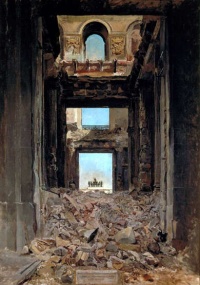Art destruction
From The Art and Popular Culture Encyclopedia
|
Related e |
|
Featured: |
Art destruction involves the damaging or destruction of works of art. This can happen through a natural process, an accident, or deliberate human involvement.
See art vandalism
Contents |
Natural destruction
All physical works of art are slowly affected and degraded by the natural elements. Some may survive long enough to allow the slow processes of erosion to act on them. Works of art may also be destroyed by natural disasters.
- The Great Sphinx of Giza is slowly eroding. Most experts believe it is a natural process, but some believe acid rain is accelerating the process.
- It is estimated that tens of thousands of works of Japanese art dating as far back as the 13th century were destroyed in the 1923 Great Kanto earthquake and the ensuing firestorm that destroyed much of central Tokyo.
- 1,400 artworks were damaged beyond repair in the November 4, 1966, floods that devastated Florence, Italy, including Cimabue's The Crucifixion.
- Ribeira Palace destroyed during 1755 Lisbon earthquake. Inside, the 70,000-volume royal library as well as hundreds of works of art, including paintings by Titian, Rubens, and Correggio, were lost. The royal archives disappeared together with detailed historical records of explorations by Vasco da Gama and other early navigators. Royal Alcazar of Madrid destroyed by fire on the Christmas Eve of 1734 with its gallery (Velazquez, Titian, Leonardo da Vinci, Raphael, etc.)
Accidental destruction
Many works of art have been damaged or destroyed by accident.
- The Stone Breakers - destroyed in the Bombing of Dresden, February 1945.
- On September 2, 1998, Swissair Flight 111 crashed near Halifax, Nova Scotia, Canada, killing 225 people. Pablo Picasso's 1963 work Le Peintre (The Painter) had been loaded on the flight as cargo and was also destroyed.
- In May 2004 a fire destroyed the Momart warehouse in east London which destroyed more than 50 works by abstract painter Patrick Heron and works by other artists.[1]
Intentional destruction
Of artwork designed to be destroyed
Many works of visual art are intended by the artist to be temporary. They may be created in media which the artist knows to be temporary, such as sand, or they may be designed specifically to be destroyed. Often the destruction takes place during a ceremony or special event highlighting the destruction. Examples of this type of art include:
Festivals where artwork is destroyed:
- The week-long Burning Man festival in the desert of Nevada, which began in 1986 With tens of thousands of participants who must pay a fee to attend, an entire city of art and self-expression is created.
- The Semana Santa (Easter week) festival in Antigua, Guatemala, where designs made out of flowers and colored sawdust are created in the street prior to being trampled by a religious parade.
- The burning of Zozobra during Fiestas de Santa Fe in Santa Fe, New Mexico, usually during the second week of September.
- The burning of falles in Valencia, Spain.
Of artwork not designed to be destroyed
Other works of art may be destroyed without the consent of the original artist or of the local community. In other instances, works of art may destroyed by a local authority against the wishes of the outside community. Examples of this include the removal of Diego Rivera's Man at the Crossroads mural from the Rockefeller Center and the destruction of the Buddhas of Bamyan statues by the Taliban government.
- Iconoclasm is the general destruction of a type of work of art for religious or ideological reasons. Most publicly visible classical art showing religious subjects was destroyed or disfigured by Christians, mostly after they had become the state religion. The same process was inflicted on classical and pagan art after the Muslim conquests, a process which continued for centuries, especially in India. The Byzantine iconoclasm was an internal process within the Greek Orthodox Church, led by changes of Byzantine Emperor, which was finally reversed after nearly a century. In the Protestant Reformation, the great majority of medieval religious art was destroyed in Protestant areas, mostly in orderly official removals, but sometimes in riotous attacks, of which the most widespread were those of the Beeldenstorm which swept the Low Countries in the summer of 1566. The French Revolution saw further destruction, both in France itself and other countries conquered in the French Revolutionary Wars.
- In the 1930s and 1940s, Nazi Germany destroyed works of art they labeled "degenerate art". These were often non-photorealistic forms of art such as cubism and surrealism. Art created by Jewish artists was also destroyed.
- Tens of thousands of works of art were destroyed in military actions in World War II. One of the best-known examples in Europe is Courbet's The Stone Breakers, which was destroyed in Dresden in 1945 during the Allied bombings. Other works of art were destroyed in the Blitz, in the bombings of Hiroshima and Nagasaki, and throughout Southeast Asia.
- Artworks destroyed in the September 11 attacks in the United States included a painted wood relief by Louise Nevelson, a painting from Roy Lichtenstein's Entablature series and a Joan Miró tapestry. The total value of artwork lost in the September 11 attacks is said to have been in excess of $100 million.[2]
- Corridart was an eight-kilometer exhibit of artworks in Montreal, intended to be part of the arts and cultural component of the 1976 Summer Olympics. Mayor Jean Drapeau, who deemed the artworks ugly, had them torn down two days before the Olympics games began.
References
See also

_-_B._Bellotto.jpg)


